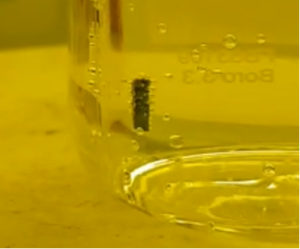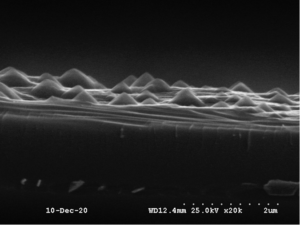Author: Pierre Chausse -
Art and Science are, I think, profoundly linked. Throughout most of human history, both artists and scientists have tried to represent reality precisely as they saw it. However, during the last two centuries we’ve seen artists break with this convention, moving away from the literal to the abstract, unnatural and sometimes even chaotic displays of art. Why not then use chaotic phenomenon to create unpredictable pictures?
Inspired to take this unique approach, I entered and won the Department of Electronic & Electrical Engineering photo competition. The bubbles created during a chaotic chemical reaction produce the apparition of circles on the surface of a sample. The circles’ shapes, diameters and depths shown through a microscope scanning created a colourful picture that looked like a psychedelic micro-nano moon. You can watch the reaction behind this image, here: https://youtu.be/2WGY9F-TXHg
On the sample, nanostructures around a thousand atoms wide have been fabricated. To modify the pattern’s shape, etching is done in a chemical bath as an additional step. When the reaction is not controlled correctly, gases are created and thus, bubbles appear.

These bubbles block the access of the liquid to the surface, creating disks. Due to the harsh reaction, none of the nanostructures remain. When the sample's surface is then analysed, a desertic landscape formed of micro-scale pyramids is observed.

Being able to modify the shape of such nanostructures is essential. Indeed, it allows us to control the characteristics of the material. Thanks to this, phenomena that doesn’t ordinarily occur in nature can be created like lasers, LEDs and biosensors. Creating repeatable recipes to generate targeted structures is therefore essential in research and industry.
Respond

